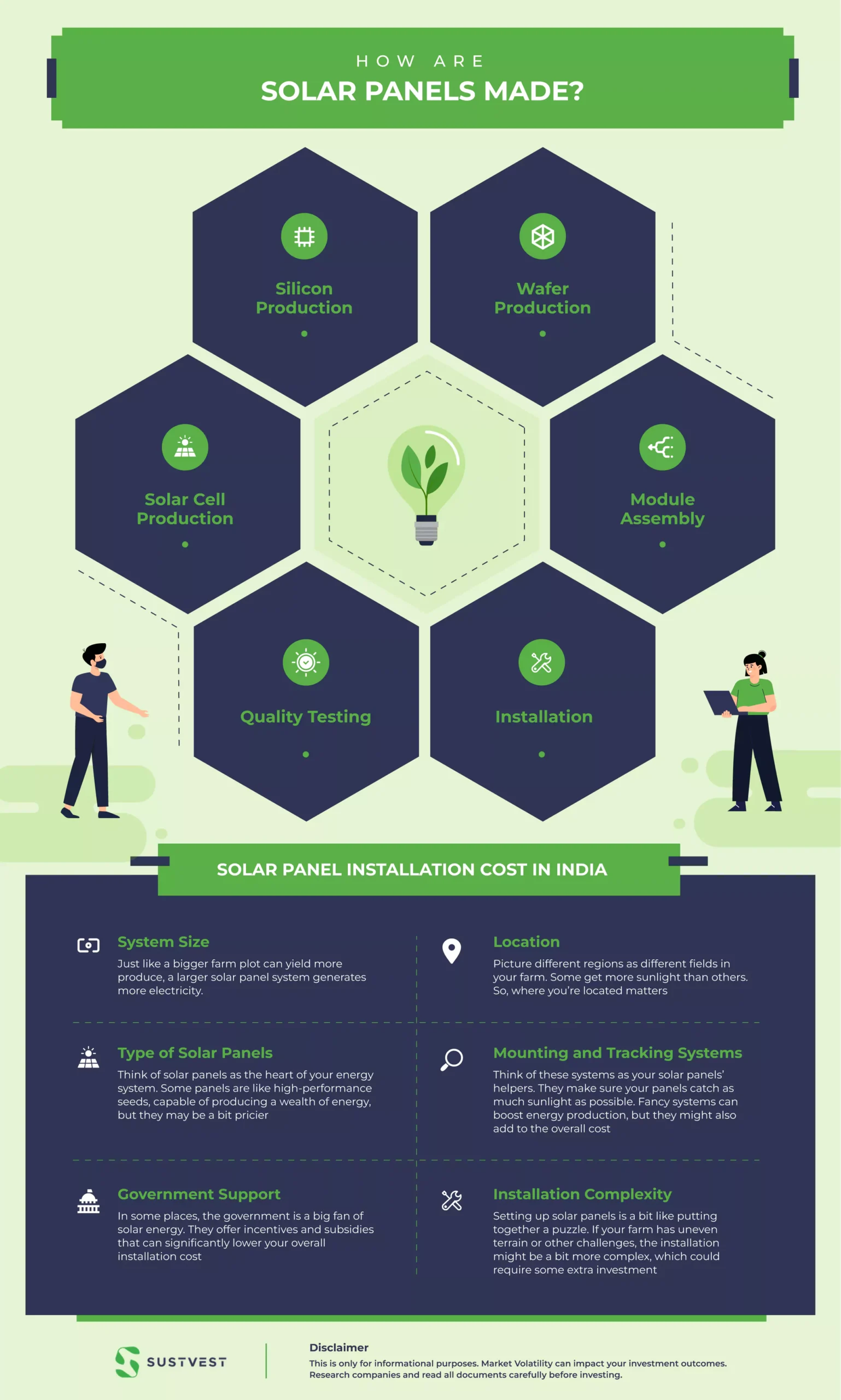Introduction
In the vast landscapes of Indian agriculture, a green revolution is quietly unfolding under the sun’s embrace. Farmers are now turning their gaze toward the heavens, where solar panels for agriculture in India are casting their sustainable glow. This article embarks on a journey through the lush fields of India, exploring the many shades of solar power in agriculture.
We’ll uncover the radiance of the solar power irrigation system, illuminate the profitability of solar panel fields, and shed light on the broader impact of solar energy in the Indian farming landscape. Plus, we’ll pause to ponder the intriguing question: Does India need a second Green Revolution? Explore more about sustainable agriculture practices at SustVest.

The Green Revolution’s Legacy
The story begins with the Green Revolution of the 1960s, a pivotal chapter in India’s agricultural history. It ushered in a period of abundant harvests and food self-sufficiency, but not without its share of shadows, notably the overreliance on chemicals.
Are Solar Panels for Agriculture Profitable in India?
Amidst the golden fields, a question emerges: Can solar panel fields for agriculture truly be a boon for Indian farmers? The answer resonates like a melodious farm song—yes, indeed. Solar panels for agriculture in India, the silent sentinels of energy, have the power to cultivate profitability from the fields.
Embracing the Sun’s Bounty: Solar Panels for Agriculture in India
Advantages and Uses of Solar Energy in Agriculture
Picture this: solar power irrigation system like leaves absorbing sunlight, offer a bouquet of benefits:
1. Sustainability: These systems harness the sun’s rays, leaving a minimal carbon footprint and bathing the fields in solar power irrigation system.
2. Cost-Efficiency: With diesel and electricity costs left behind, farmers reap the financial harvest of lower operational expenses.
3. Energy Independence: Solar power ensures a reliable energy source, reducing dependence on erratic power grids.
Uses of Solar Panels for Agriculture in India
Beyond irrigation, solar energy for agriculture in India scripts its tale in diverse ways:
– Solar Agri-feeders: In this sunny narrative, animals thrive under the gentle care of solar agri-feeders, which reduce operational costs and ensure the welfare of livestock.
-Electricity Generation: Solar panels emerge as storytellers of electricity, crafting narratives of income streams from vast agricultural lands.
Powering Agriculture in India: The Pavagada Solar Park
How Has the Pavagada Solar Park Impacted India?
In the heartlands of Karnataka, you’ll find the remarkable Pavagada Solar Park, standing as a shining symbol of India’s unwavering dedication to harnessing the power of the sun. But this solar park is more than just an energy hub; it illuminates the exciting possibilities of combining solar energy with agriculture.
How Are Solar Panels Made?
Let’s dive into the intriguing process of crafting solar panels. Creating solar panels involves several well-defined steps, each with a specific purpose:
1. Silicon Production:
First, we source silicon, a fundamental material that’s refined to remove impurities. It’s then shaped into crystalline structures.
2. Wafer Production:
Imagine cutting thin wafers from the purified silicon. These wafers serve as the core building blocks for solar cells.
3. Solar Cell Production:
These silicon wafers undergo treatments with various materials to create photovoltaic cells. These cells are like the magic components; they convert sunlight into electricity.
4. Module Assembly:
Now, these solar cells are carefully connected and enclosed between protective layers, creating what we call a solar module.
5. Quality Testing:
Before these modules leave the factory, they go through meticulous testing. This ensures they meet stringent quality standards, ensuring their reliability and efficiency.
6. Installation:
Finally, these solar modules are ready to be installed, be it on rooftops, in solar farms, or even on agricultural lands. Once in place, they start their mission of capturing sunlight and generating clean, sustainable energy.
Here is a A Comprehensive Guide to Different Types of Solar Systems and their Benefits which will help in selecting the type of solar system required according to the needs of a farmer.

Solar Panel Installation Cost in India
Before delving further, it’s essential to consider the solar installation cost in India. This cost varies but has been witnessing a downward trend due to government incentives and technological advancements.
When considering the expenses involved in installing solar panels, imagine it as tending to your solar energy garden. Various elements influence the overall cost:
1. System Size:
Just like a bigger farm plot can yield more produce, a larger solar panel system generates more electricity. But, of course, it might need a bit more upfront investment.
2. Location:
Picture different regions as different fields in your farm. Some get more sunlight than others. So, where you’re located matters. More sun usually means more energy and a quicker return on investment, but it can also affect initial costs.
3. Type of Solar Panels:
Think of solar panels as the heart of your energy system. Some panels are like high-performance seeds, capable of producing a wealth of energy, but they may be a bit pricier. Meanwhile, there are more economical options that, like dependable seeds, provide energy but may not be as efficient.
4. Mounting and Tracking Systems:
Think of these systems as your solar panels’ helpers. They make sure your panels catch as much sunlight as possible. Fancy systems can boost energy production, but they might also add to the overall cost.
5. Government Support:
In some places, the government is a big fan of solar energy. They offer incentives and subsidies that can significantly lower your overall installation cost. It’s like getting a bonus for growing a particular crop.
6. Installation Complexity:
Setting up solar panels is a bit like putting together a puzzle. If your farm has uneven terrain or other challenges, the installation might be a bit more complex, which could require some extra investment.
Remember, there are also other costs to consider, like permits, electrical work, and the quality of components. Plus, economies of scale can make a difference – bigger installations can sometimes cost less per unit.
FAQs: Solar Panels for Agriculture in India: Cultivating the Green Revolution
Q1. Are solar panel fields for agriculture in India profitable for Indian farmers?
A1. Like a golden harvest, solar panel fields yield long-term profitability, diminishing operational costs and offering a bounty through surplus energy production.
Q2. How do solar panels help farmers in India?
A2. Solar panels power the solar power irrigation system, reducing reliance on costly fuels and ensuring a steady water supply for crops and livestock.
Q3. Does India need a second Green Revolution?
A3. The seeds of a second Green Revolution, rooted in sustainability and solar energy in agriculture integration,may hold the key to overcoming modern agricultural challenges.
Q4. How has the Pavagada Solar Park impacted India?
A4. This solar park serves as an emblem of India’s dedication to solar energy and offers valuable lessons for cultivating sustainable agricultural development.
Q5. Can solar Agri-feeders help the agricultural sector?
A5. These sunlit agri-feeders not only reduce operational expenses but also nurture the well-being of livestock, contributing to overall farm profitability.
Q6. Are solar panels used to generate electricity on agricultural land?
A6. Yes, solar panels are spreading their wings to generate electricity on vast agricultural lands, adding an extra sheen to the farmer’s income.
Conclusion
In the tapestry of Indian agriculture, the threads of solar panels are weaving a story of hope and sustainability. These silent sentinels not only trim operational costs but also illuminate the path toward a greener and more prosperous farming future. As we contemplate the need for a second Green Revolution, the sun’s wisdom shines brightly—it whispers that solar panels for agriculture in India aren’t just a modern innovation; they are the seeds of a sustainable tomorrow, where profitability and environmental stewardship walk hand in hand.
Now, let’s delve into a crucial aspect that affects farmers’ decisions regarding solar panels: Is it Better to Lease or Buy Solar Panels – A Comparative Analysis. This decision can significantly impact the financial and environmental outcomes for Indian farmers. To learn more about it and solar solutions, visit SustVest.

Founder of Sustvest
Hardik completed his B.Tech from BITS Pilani. Keeping the current global scenario, the growth of renewable energy in mind, and people looking for investment opportunities in mind he founded SustVest ( formerly, Solar Grid X ) in 2018. This venture led him to achieve the ‘Emerging Fintech Talent of the Year in MENA region ‘ in October 2019.




